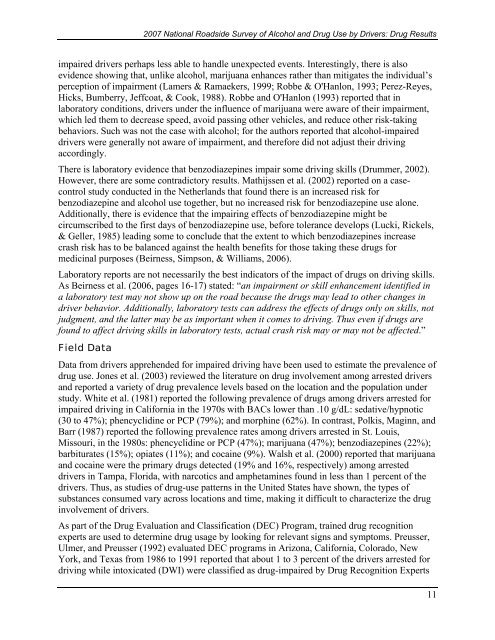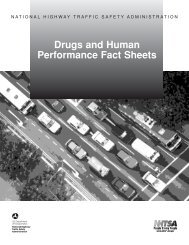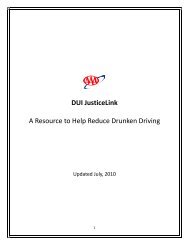2007 National Roadside Survey of Alcohol and Drug Use by Drivers
2007 National Roadside Survey of Alcohol and Drug Use by Drivers
2007 National Roadside Survey of Alcohol and Drug Use by Drivers
You also want an ePaper? Increase the reach of your titles
YUMPU automatically turns print PDFs into web optimized ePapers that Google loves.
<strong>2007</strong> <strong>National</strong> <strong>Roadside</strong> <strong>Survey</strong> <strong>of</strong> <strong>Alcohol</strong> <strong>and</strong> <strong>Drug</strong> <strong>Use</strong> <strong>by</strong> <strong>Drivers</strong>: <strong>Drug</strong> Resultsimpaired drivers perhaps less able to h<strong>and</strong>le unexpected events. Interestingly, there is alsoevidence showing that, unlike alcohol, marijuana enhances rather than mitigates the individual’sperception <strong>of</strong> impairment (Lamers & Ramaekers, 1999; Robbe & O'Hanlon, 1993; Perez-Reyes,Hicks, Bumberry, Jeffcoat, & Cook, 1988). Robbe <strong>and</strong> O'Hanlon (1993) reported that inlaboratory conditions, drivers under the influence <strong>of</strong> marijuana were aware <strong>of</strong> their impairment,which led them to decrease speed, avoid passing other vehicles, <strong>and</strong> reduce other risk-takingbehaviors. Such was not the case with alcohol; for the authors reported that alcohol-impaireddrivers were generally not aware <strong>of</strong> impairment, <strong>and</strong> therefore did not adjust their drivingaccordingly.There is laboratory evidence that benzodiazepines impair some driving skills (Drummer, 2002).However, there are some contradictory results. Mathijssen et al. (2002) reported on a casecontrolstudy conducted in the Netherl<strong>and</strong>s that found there is an increased risk forbenzodiazepine <strong>and</strong> alcohol use together, but no increased risk for benzodiazepine use alone.Additionally, there is evidence that the impairing effects <strong>of</strong> benzodiazepine might becircumscribed to the first days <strong>of</strong> benzodiazepine use, before tolerance develops (Lucki, Rickels,& Geller, 1985) leading some to conclude that the extent to which benzodiazepines increasecrash risk has to be balanced against the health benefits for those taking these drugs formedicinal purposes (Beirness, Simpson, & Williams, 2006).Laboratory reports are not necessarily the best indicators <strong>of</strong> the impact <strong>of</strong> drugs on driving skills.As Beirness et al. (2006, pages 16-17) stated: “an impairment or skill enhancement identified ina laboratory test may not show up on the road because the drugs may lead to other changes indriver behavior. Additionally, laboratory tests can address the effects <strong>of</strong> drugs only on skills, notjudgment, <strong>and</strong> the latter may be as important when it comes to driving. Thus even if drugs arefound to affect driving skills in laboratory tests, actual crash risk may or may not be affected.”Field DataData from drivers apprehended for impaired driving have been used to estimate the prevalence <strong>of</strong>drug use. Jones et al. (2003) reviewed the literature on drug involvement among arrested drivers<strong>and</strong> reported a variety <strong>of</strong> drug prevalence levels based on the location <strong>and</strong> the population understudy. White et al. (1981) reported the following prevalence <strong>of</strong> drugs among drivers arrested forimpaired driving in California in the 1970s with BACs lower than .10 g/dL: sedative/hypnotic(30 to 47%); phencyclidine or PCP (79%); <strong>and</strong> morphine (62%). In contrast, Polkis, Maginn, <strong>and</strong>Barr (1987) reported the following prevalence rates among drivers arrested in St. Louis,Missouri, in the 1980s: phencyclidine or PCP (47%); marijuana (47%); benzodiazepines (22%);barbiturates (15%); opiates (11%); <strong>and</strong> cocaine (9%). Walsh et al. (2000) reported that marijuana<strong>and</strong> cocaine were the primary drugs detected (19% <strong>and</strong> 16%, respectively) among arresteddrivers in Tampa, Florida, with narcotics <strong>and</strong> amphetamines found in less than 1 percent <strong>of</strong> thedrivers. Thus, as studies <strong>of</strong> drug-use patterns in the United States have shown, the types <strong>of</strong>substances consumed vary across locations <strong>and</strong> time, making it difficult to characterize the druginvolvement <strong>of</strong> drivers.As part <strong>of</strong> the <strong>Drug</strong> Evaluation <strong>and</strong> Classification (DEC) Program, trained drug recognitionexperts are used to determine drug usage <strong>by</strong> looking for relevant signs <strong>and</strong> symptoms. Preusser,Ulmer, <strong>and</strong> Preusser (1992) evaluated DEC programs in Arizona, California, Colorado, NewYork, <strong>and</strong> Texas from 1986 to 1991 reported that about 1 to 3 percent <strong>of</strong> the drivers arrested fordriving while intoxicated (DWI) were classified as drug-impaired <strong>by</strong> <strong>Drug</strong> Recognition Experts11




